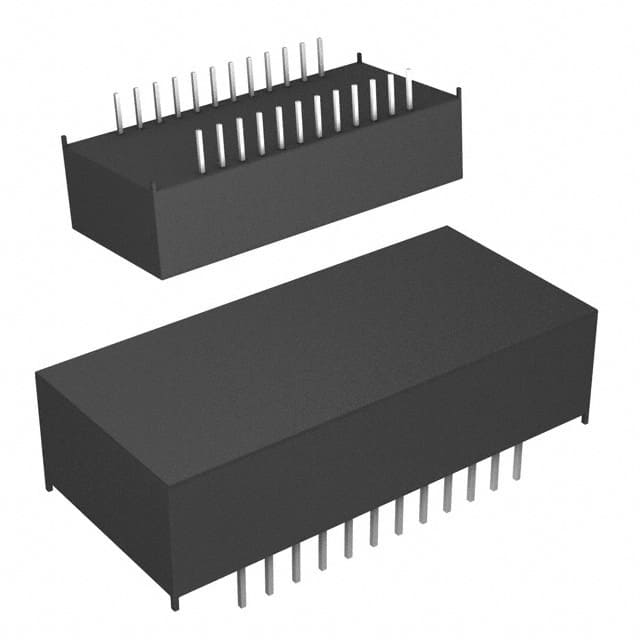DS12887A+ - English Editing Encyclopedia Entry
Product Overview
Category: Integrated Circuit (IC)
Use: Real-Time Clock (RTC) chip
Characteristics: - Low-power CMOS technology - Battery-backed clock/calendar - 114 bytes of non-volatile RAM - I2C bus interface - Automatic power-fail detect and switch circuitry - Programmable square wave output - Industrial temperature range (-40°C to +85°C) - Small package size (e.g., 24-pin DIP)
Package: Plastic Dual In-line Package (DIP)
Essence: The DS12887A+ is a highly integrated real-time clock chip designed for various applications that require accurate timekeeping.
Packaging/Quantity: The DS12887A+ is typically sold in reels or tubes, with quantities varying based on customer requirements.
Specifications
- Supply Voltage: 4.5V to 5.5V
- Timekeeping Current: 500nA (typical)
- Operating Temperature Range: -40°C to +85°C
- Clock Accuracy: ±2 minutes per month at 25°C
- Data Retention: >10 years
- I2C Bus Frequency: Up to 400kHz
- Square Wave Output Frequency: Programmable from 1Hz to 32.768kHz
Detailed Pin Configuration
The DS12887A+ has a total of 24 pins, each serving a specific function. Here is the detailed pin configuration:
- VCC - Power supply voltage
- GND - Ground
- X1 - Crystal oscillator input
- X2 - Crystal oscillator output
- IRQ - Interrupt request output
- SQW/OUT - Square wave output
- SDA - Serial data line (I2C bus)
- SCL - Serial clock line (I2C bus)
- A0-A6 - Address inputs
- CE - Chip enable input
- RESET - Reset input 12-24. NC - No connection
Functional Features
- Real-Time Clock: Provides accurate timekeeping functionality.
- Non-Volatile RAM: Stores critical data even when power is lost.
- I2C Bus Interface: Allows easy communication with other devices.
- Power-Fail Detection: Automatically switches to battery backup during power loss.
- Programmable Square Wave Output: Generates square wave signals of various frequencies.
- Industrial Temperature Range: Suitable for harsh operating conditions.
Advantages and Disadvantages
Advantages: - Low power consumption - Small package size - High accuracy timekeeping - Battery backup for data retention - Wide operating temperature range
Disadvantages: - Limited non-volatile RAM capacity (114 bytes) - Requires an external crystal oscillator for clock accuracy
Working Principles
The DS12887A+ utilizes a low-power CMOS technology to provide real-time clock functionality. It relies on an external crystal oscillator for accurate timekeeping. The chip communicates with other devices through the I2C bus interface, allowing seamless integration into various systems. In case of a power failure, the DS12887A+ automatically switches to battery backup mode, ensuring uninterrupted timekeeping and data retention.
Detailed Application Field Plans
The DS12887A+ finds applications in various fields, including but not limited to: - Embedded systems - Consumer electronics - Industrial automation - Medical devices - Automotive systems
Its accurate timekeeping capability makes it suitable for applications that require precise scheduling, event logging, or time-based operations.
Detailed and Complete Alternative Models
- DS3231 - Highly accurate RTC module with integrated temperature compensation.
- PCF8563 - Low-power RTC chip with alarm and timer functions.
- MCP7940N - I2C RTC chip with battery backup and SRAM.
These alternative models offer similar functionality to the DS12887A+ and can be considered as alternatives based on specific requirements.
In conclusion, the DS12887A+ is a versatile real-time clock chip that provides accurate timekeeping and non-volatile data storage capabilities. Its low power consumption, small package size, and wide operating temperature range make it suitable for various applications in different industries.
قم بإدراج 10 أسئلة وإجابات شائعة تتعلق بتطبيق DS12887A+ في الحلول التقنية
Sure! Here are 10 common questions and answers related to the application of DS12887A+ in technical solutions:
Q: What is DS12887A+? A: DS12887A+ is a real-time clock (RTC) integrated circuit commonly used in technical solutions for timekeeping and calendar functions.
Q: How does DS12887A+ communicate with other devices? A: DS12887A+ communicates using an I2C (Inter-Integrated Circuit) interface, which allows it to connect with microcontrollers or other devices.
Q: Can DS12887A+ operate on its own without external components? A: No, DS12887A+ requires an external 32.768 kHz crystal oscillator for accurate timekeeping.
Q: What is the power supply requirement for DS12887A+? A: DS12887A+ typically operates on a 5V power supply, but it also has a backup battery input for maintaining timekeeping during power outages.
Q: How accurate is DS12887A+ in timekeeping? A: DS12887A+ has a typical accuracy of ±2 minutes per month when operated within specified temperature ranges.
Q: Can DS12887A+ handle leap years and daylight saving time changes? A: Yes, DS12887A+ has built-in support for leap years and can be programmed to adjust for daylight saving time changes.
Q: Can DS12887A+ generate alarms or interrupts? A: Yes, DS12887A+ has alarm functionality that can trigger an interrupt signal to alert the system when a specific time or date is reached.
Q: Is DS12887A+ compatible with low-power modes? A: Yes, DS12887A+ supports low-power modes, allowing it to conserve energy when not actively used.
Q: Can DS12887A+ be used in battery-powered devices? A: Yes, DS12887A+ can be used in battery-powered devices as it has a backup battery input for maintaining timekeeping during power loss.
Q: Are there any limitations or considerations when using DS12887A+? A: One consideration is that DS12887A+ operates within specific temperature ranges (-40°C to +85°C) and may require additional circuitry for temperature compensation if used outside these limits. Additionally, proper handling of I2C communication and addressing is necessary for successful integration into a technical solution.
Please note that the answers provided are general and may vary depending on the specific implementation and requirements of the technical solution.


